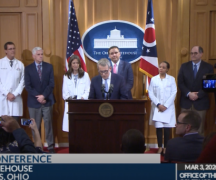With in-person voting an untenable option during the ongoing health pandemic, Ohioans will instead vote by mail this month as part of an “extended” primary election.
Citizens still have a few more weeks — through April 28 — to apply for an absentee ballot, then send their completed ballot to their local board of elections office to be counted.
There are numerous voting security safeguards in place with this system. Despite that, President Trump has repeatedly argued in recent days that the system encourages cheating and voter fraud. He also argues that only Democrats are pushing for absentee balloting as a means of attaining a political advantage.
The evidence shows otherwise. Here are the facts about voting by mail:
The system does not encourage cheating/voter fraud.
At his daily COVID-19 news conferences, the president has been clear about his views toward a voting by mail system.
“It shouldn’t be mail-in voting … all sorts of bad things can happen,” Trump has said.
In another exchange, a reporter asked: “Do you think every state in this country should be prepared for mail-in voting?”
Trump replied: “No, because I think a lot of people cheat with mail-in voting.”
In reality, voter fraud is extraordinarily rare in Ohio and other states that allow for voting by mail. After the November 2016 General Election, then-Secretary of State Jon Husted referred just 52 cases to prosecutors out of 5.6 million votes cast, a story from cleveland.com reported. That is a rate of just .001% of all votes cast.
About one-third of those 5.6 million votes were cast through the mail. There is no evidence that a mail-in ballot system leads to a disproportionate level of voter fraud.
It is not just Democrats pushing for a mail-only vote.
Trump believes Democrats are “clamoring” for mail-in voting in order to benefit the party politically:Donald J. Trump✔@realDonaldTrump
Republicans should fight very hard when it comes to state wide mail-in voting. Democrats are clamoring for it. Tremendous potential for voter fraud, and for whatever reason, doesn’t work out well for Republicans. @foxandfriends144KTwitter Ads info and privacy76.2K people are talking about this
Ohio is a noteworthy example where that is not true.
The present plan was decided by the state legislature through passage of House Bill 197. It set the April 28 deadline and the mail-only system.
The vote was 92-0 in the Ohio House of Representatives and 29-0 in the Ohio Senate. The Republicans hold supermajorities in both chambers.
There are actually a handful of western states which conduct elections entirely through the mail, according to the National Conference of State Legislatures, including Republican-leaning Utah. Around two-dozen other states, such as Ohio, also allow mail-in voting under certain circumstances.
Ohio’s absentee ballot system does have voter fraud safeguards.
Trump has argued that in-person voting is preferable because of the physical presence of voter identification. He has implied that voting by mail does not include any safeguards to voter fraud.
“The reason they don’t want voter ID is because they intend to cheat,” he said at a news conference.
The theory is that ballots could be filled out and returned by the wrong person. In reality, Ohio’s system does account for this.
Blank ballots are not just automatically sent to every household. Voters must submit an absentee ballot application to their county board of elections. They are required to confirm their identification: options include providing an Ohio driver’s license number or the last four digits of a social security number.
Another important aspect is the signature given on the application form, according to Maggie Sheehan, a spokesperson for the Ohio Secretary of State’s Office. The signature is compared to the one on file with a voter’s original registration, Sheehan noted.
If anything, this check has proven to be overly scrupulous. The Associated Press reported last year that thousands of absentee voter applications were denied because the signatures did not match.
In essence, Ohioans do not even get a ballot to fill out unless their local elections officials determine they are a legitimate voter.
Only then are they sent a ballot with a sealable envelope. The voter must again provide their signature and verification details, Sheehan said, which are again checked by election officials to process the ballot.
After mailing them in, voters can track their ballots online at voteohio.gov.
“Once received by the county board of elections, ballots are stored securely under lock and key and can only be accessed by a Republican and Democratic election official who enter the room together,” Sheehan added. “Finally, upon completion of the election, a post-election audit is conducted to confirm the accuracy of the election.”
Trump has a history of making unfounded voter fraud claims.
The president’s recent comments about mail-in balloting are part of a yearslong effort to discredit the American voting system.
This talk began before the 2016 presidential election even took place. He claimed in the fall of 2016 that the election was rigged against him.
Even after winning, Trump repeatedly claimed (without evidence) that millions of people voted illegally:Donald J. Trump✔@realDonaldTrump
In addition to winning the Electoral College in a landslide, I won the popular vote if you deduct the millions of people who voted illegally141KTwitter Ads info and privacy90.9K people are talking about this
Allegations of election fraud have returned with Trump now running for reelection.
Lara Trump, the president’s daughter-in-law, is serving as a Trump campaign adviser and made similar claims at a January 2020 rally in Columbus, the Ohio Capital Journal previously reported. It went further than criticism of voting by mail — Lara Trump claimed (without evidence) the Democrats were defrauding the voter registration system and would cheat at the polls.
“Sometimes when people get desperate, sometimes they try and cheat. I’m just throwing it out there. So we have to be on guard,” she told supporters, encouraging them to keep an eye out at their polling places.
“We gotta watch the polls, make sure no funny business is happening when people are voting,” Trump said, “cause you know they’re trying to register dead people still and do all that crazy stuff. They’re desperate, they’re doing anything they can.”
Ohio Republicans are not discrediting Trump’s claims, but voters can read between the lines.
This election issue is the latest example of a widening gap in messaging between state leaders and the White House.
Trump said untested drugs can treat COVID-19, while Dr. Amy Acton said the evidence isn’t yet clear. Trump wanted to reopen the country by Easter, while DeWine decided to extend the stay-at-home order.
DeWine and Republican Secretary of State Frank LaRose are encouraging voter participation. Trump bashes the system as corrupt and tells Republicans to “fight very hard”against statewide mail-in voting.
In this case, as with the previous examples, DeWine refuses to pick a fight with the president. It is not for lack of opportunity: members of the Ohio press corps have repeatedly asked DeWine to explain this evident dichotomy.
The governor has made a point of ignoring or pivoting away these questions. Asked about the president of the United States insisting to Ohio voters their system is corrupted, DeWine opted for a comfortable Republican play during the Trump area: “I didn’t hear the president’s comments.” Then he moved on.
The reporter, Andy Chow of the Statehouse Press Corps, followed up: “And you believe Ohio’s process is safe, not corrupt?” Chow was again referring to the integrity of the election vis-a-vis Trump’s comments. DeWine, however, answered in the context of protecting voters from the virus:Video Player
LaRose has not commented publicly about the president’s claims of voter fraud. He has spent the month informing voters on how the absentee balloting process works ahead of the late-April deadline.
For more information about how to cast a ballot in the 2020 Ohio primary election, read this Ohio Capital Journal Q&A or visit the Secretary of State website.





